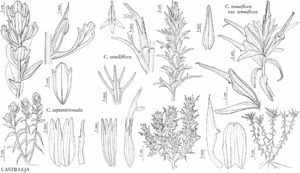Castilleja sessiliflora
Fl. Amer. Sept. 2: 738. 1813.
Herbs, perennial, 1–4 dm; from a branching, woody caudex; with a taproot. Stems few to many, ascending to erect, often decumbent at base, unbranched, sometimes branched, hairs spreading, sometimes matted, short to medium length, ± soft, eglandular, often with a layer of minute-glandular hairs, sometimes woolly. Leaves green to purple, or grayish with dust and hairs, linear to narrowly lanceolate, (1–)2–5(–6) cm, not fleshy, margins plane, involute, (0–)3–5-lobed, apex acuminate to acute; lobes divergent, spreading, linear, apex acute. Inflorescences 3–18 × 2.5–6.5 cm; bracts green to purplish throughout, sometimes reddish brown, pink, or lavender throughout, or distally white or pale yellow, sometimes distally dull pink, pink, salmon, orangish, pale pink-orange, buff, or cream, lanceolate, similar to distal leaves, 3(–5)-lobed; lobes spreading, linear-lanceolate, long, arising at or below mid length, apex acute to acuminate, sometimes obtuse. Calyces colored as bracts, sometimes proximally white, 20–40 mm; abaxial and adaxial clefts 12–20 mm, 40–60% of calyx length, deeper than laterals, lateral 5–15 mm, 10–25% of calyx length; lobes linear, apex acute to acuminate. Corollas strongly curved distally, 35–55 mm; tube 24–45 mm; abaxial lip, beak, and distal portion of tube exserted; beak adaxially green, yellow, pinkish, purplish, or whitish, 9–15 mm; abaxial lip green, pale green, or purple, protruding, shelflike, 4–8 mm, 50–70% as long as beak; teeth spreading, white, pale yellow, pink, or purple, 3–4 mm. 2n = 24.
Phenology: Flowering (Feb–)Mar–Aug(–Oct).
Habitat: Dry mixed grass and shortgrass prairies, prairie sandhills, sandsage plains, sand prairies, rocky or sandy slopes, bluffs, open forests, or desert scrub, limestone, sandstone, gypsum, granite, other bedrock types.
Elevation: 0–2300 m.
Distribution
Alta., Man., Sask., Ariz., Colo., Ill., Iowa, Kans., Minn., Mo., Mont., Nebr., N.Mex., N.Dak., Okla., S.Dak., Tex., Wis., Wyo., Mexico (Coahuila, Nuevo León, Tamaulipas).
Discussion
Castilleja sessiliflora ranges across the Great Plains from southern Canada to northern Mexico, where it is apparently rare. In Texas and northern Mexico, its range overlaps with the similar C. mexicana. Most populations of C. sessiliflora, especially north of Texas, have white to pale yellow inflorescences; in southwestern Texas they are more variable in color, with pink-purple plants often predominating locally. Those plants with pink-purple inflorescences were named forma purpurina by F. W. Pennell. In the limestone deserts of southern New Mexico and southeastern Arizona, the inflorescences are often a pale pink-orange, but these are intermingled with more typical greenish white plants. Occasional hybrids between C. angustifolia var. dubia and C. sessiliflora are known from northeastern Wyoming.
Selected References
None.
